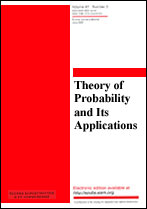|
This article is cited in 2 scientific papers (total in 2 papers)
Some problems in probabilistic tomography
D. Applegatea, J. Reedsa, S. Scheinbergb, L. Sheppa, P. Shora
a AT&T Bell Laboratories, Murray Hill, NJ
b U. C. Irvine, Math Department
Abstract:
Given probability distributions $F_1 , F_2 , \ldots , F_k$ on $\mathbb R$ and distinct directions $\theta_1, \ldots , \theta_k$, one may ask whetherthere is a probability measure $\mu$ on $\mathbb R^2$ such that the marginal of $\mu$ in direction $\theta_j$ is $F_j$, $j=1, \ldots , k$. For example for $k=3$ we ask what the marginal of $\mu$ at $45^\circ$ can be if the $x$ and $y$ marginals are each say standard normal? In probabilistic language, if $X$ and $Y$ are each standard normal with an arbitrary joint distribution, what can the distribution of $X+Y$ or $X-Y$ be? This type of question is familiar to probabilists and is also familiar (except perhaps in that $\mu$ is positive) to tomographers, but is difficult to answer in special cases. The set of distributions for $Z = X-Y$ is a convex and compact set, $C$, which contains the single point mass $Z \equiv 0$ since $X \equiv Y$, standard normal, is possible. We show that $Z$ can be 3-valued, $Z=0$, $\pm a$ for any $a$, each with positive probability, but $Z$ cannot have any (genuine) two-point distribution. Using numerical linear programming we present convincing evidence that $Z$ can be uniform on the interval $[-\varepsilon,\varepsilon]$ for $\varepsilon$ small and give estimates for the largest such $\varepsilon$. The set of all extreme points of $C$ seems impossible to determine explicitly.
We also consider the more basic question of finding the extreme measures on the unit square with uniform marginals on both coordinates, and show that not every such measure has a support which has only one point on each horizontal or vertical line, which seems surprising.
Keywords:
marginal distributions, extreme point, Radon.
Received: 04.07.1994
Citation:
D. Applegate, J. Reeds, S. Scheinberg, L. Shepp, P. Shor, “Some problems in probabilistic tomography”, Teor. Veroyatnost. i Primenen., 41:2 (1996), 323–335; Theory Probab. Appl., 41:2 (1997), 199–209
Linking options:
https://www.mathnet.ru/eng/tvp2937https://doi.org/10.4213/tvp2937 https://www.mathnet.ru/eng/tvp/v41/i2/p323
|


|




 Contact us:
Contact us: Terms of Use
Terms of Use
 Registration to the website
Registration to the website Logotypes
Logotypes








 Citation in format
Citation in format 
